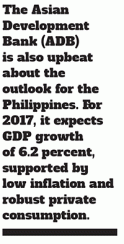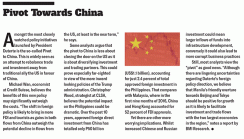To view a PDF of the report, click here.
With strong economic fundamentals, the country continues to offer bright long-term growth prospects, even in the face of political uncertainty.
By almost any measure, investor sentiment has been extraordinary. As recently as July 2016, the Philippines was still widely viewed as one of the most promising emerging markets in Asia. Foreign direct investment was on a roll, and Philippine stocks were close to record highs. That momentum has cooled a bit of late. Whilst the MSCI Asia Pacific Index has risen by 17 percent since 1 July, the MSCI Philippines Index has actually fallen by close to 10 percent. Meanwhile, the peso has depreciated by 5 percent against the US dollar over the same period.
In large part, investor jitters are the result of President Rodrigo Duterte’s controversial war on drugs and widespread fears that it flouts international laws. Global investors are also concerned about Duterte’s provocative behaviour, his firebrand rhetoric and his calls for a shift away from the country’s long-term ally – the US – in favour of stronger economic relations with China.
Paradoxically, the tough-talking leader remains beloved in the Philippines, with popularity ratings of close to 80 percent at the end of 2016—a level that most Western politicians can only dream of achieving. On the ground, the Philippine economy continues to power ahead. For the fourth quarter of 2016, GDP grew at 6.6 percent on the back of increased investment and domestic consumption. Public investment in infrastructure remained strong, with public construction expanding by 23 percent. External demand also improved with exports rising by 9.6 percent.
The latest economic indicators continue to project solid growth for 2017, although understandably easing after last year’s presidential elections. Diana Del-Rosario, an economist at Deutsche Bank in Singapore, believes there could be some upside to consumer spending from the recently approved pension increase for Social Security System beneficiaries, as well as from the planned salary increases for military and civil servants. She is reluctant to revise up Deutsche Bank’s 5.8 percent GDP growth forecast, however, given risks of private sector investment deceleration and protectionist moves under a Trump-led US.
The Asian Development Bank (ADB) is also upbeat about the outlook for the Philippines. For 2017, it expects GDP growth of 6.2 percent, supported by low inflation and robust private consumption.
As with any emerging economy, foreign investors should expect a bumpy ride. Whilst rating agency Moody’s lauds the Philippines’ sound economic and fiscal fundamentals, it warns that political risks have become less predictable and that progress is likely to depend on whether President Duterte deploys his considerable political capital to accelerate infrastructure development and tax reform. At the same time, it notes “a sustained focus on political issues could detract attention away from reform.”
On the external front, global investors are also closely watching the potential impact of US protectionism. In particular, there are fears that the country’s outsourcing companies could take a hit from Donald Trump’s plan to bring back jobs to America. The impact could be significant. Last year, revenues in the business-process outsourcing (BPO) sector were estimated at US$23 billion, making it one of the country’s largest foreign exchange earners. Combined with weaker remittances from Filipino workers in the US, this could cause the current account balance to narrow, putting additional pressure on the local currency.
Reform agenda

Perhaps more importantly, the country is playing economic catch-up with its Asian neighbours. For years, the Philippines was known as ‘the basket case of Asia’. The country suffered from endemic corruption, a bloated budget, a slow-growing economy, and a record of political instability. All that changed, however, in 2010, following the appointment of President Benigno Aquino III. One of the President’s first steps was to launch a massive crackdown on corruption. Furthermore, he closed tax loopholes, moved to address the country’s yawning fiscal deficit, and removed many of the bureaucratic and legal obstacles that made the Philippines a less attractive place for foreign investors. His efforts were rewarded in 2013 when the Philippines won investment grade credit ratings from all the major international rating agencies.
Yet in terms of infrastructure development, per capita income, and private investment, the Philippines continues to languish well below ASEAN countries like Thailand, meaning that it will take a number of years for the country to close the gap.
For his part, President Duterte has made it clear that he will continue his predecessor’s broad economic policies. In this respect, he is supported by an able team of economic managers. Secretary of Finance, Carlos “Sonny” Dominguez, has over 40 years of experience in the public and private sectors. He is a former president of Philippine Airlines, as well as the head of Philippine Islands Agricultural Bank.

Another stable hand on the tiller of the economic team is veteran central bank governor Amando Tetangco. Widely recognized in the banking industry, Tetangco has worked at the central back for almost 40 years and is one of the first men to have served two terms as governor. Tetangco’s term ends on 2 July this year. Many analysts are hoping that he can be persuaded to stay on for a third term.
Going forward, one of the big questions confronting the central bank is how much longer it can stand pat on interest rates in the face of rising inflationary pressure. On the back of a significant increase in food, beverages, tobacco, and transport costs, inflation jumped in February to 3.3 percent year-on-year from 2.7 percent in January. Euben Paracuelles, senior economist at Nomura Securities, predicts that the central bank will raise rates in the near future. “We maintain our forecast that BSP (the central bank) will hike rates by a cumulative 50 basis points in the first half of 2017,” he says.

Infrastructure ambitions
It is no secret that sustaining growth of the economy may well depend on the government’s ability to deliver on its ambitious infrastructure building program. Touted as the biggest infrastructure push in Philippine history, budget secretary Benjamin Diokno has said the administration will spend up to P9 trillion from 2017 to 2022 in a bid to close the infrastructure gap with neighbouring Asian countries. On his ‘wish’ list are everything from new roads and airports to bridges and mass urban transport systems.
The impact could be far-reaching. One priority project is a high-speed railway linking Metro Manila with Clark International Airport and Clark Freeport Zone. If the project gets the green light, it will reduce travel time from nearly three hours to just one hour. The government is also eyeing up a railway network on Mindanao, which is the second biggest island in the Philippines. Such a move is seen as crucial to decentralizing economic power away from Manila and bringing greater economic development to cities such as Davao, Zamboanga, and General Santos. These big-ticket infrastructure projects have the potential to create hundreds of thousands of jobs, boost investment and lower the cost of doing business in the Philippines, which has long been a major gripe of foreign investors.
Nonetheless, building big-ticket infrastructure projects is fraught with problems. Already there have been delays. According to Jose-Paolo Fontanilla, an analyst at CLSA in Manila, the bidding for the regional airports public-private partnership (PPP) has been put back a year from its original target date. The new indicative timeline for bidding is now set for November 2017. “The slow PPP rollout raises valid concerns on the Philippines’ infrastructure growth story, with the administration seemingly pre-occupied with the war on drugs and other political issues,” he says. Some analysts believe the new administration is erring on the side of caution in order to ensure a more transparent procurement process and avoid pitfalls such as wasteful spending and contingent liabilities.
Several other PPPs are scheduled for bidding later this year. They include the Regional Prison Facilities set for the end of April, and the New Nayong Pilipino, a cultural theme park, slated for December.
Comprehensive tax reform
Another key element of President Duterte’s reform plan is the so-called Comprehensive Tax Reform Program. Widely viewed as an attempt to close tax loopholes and overhaul outdated procedures, the latest version of the tax reform bill proposes a reduction in personal income tax rates and estate taxes, as well as the simplification of tax brackets. During the first year of implementation, the tax cuts are expected to result in lower revenues. However, this will be more than offset by increasing fuel and automobile excise taxes, removing VAT exemptions, and boosting measures to improve tax administration. This in turn could help finance the government’s much needed investment in infrastructure. Deutsche Bank’s Del-Rosario believes the passage of the bill would be “a welcome development for a low- income country with one of the highest income tax rates in Asia”. Better still, it would give the Duterte government the momentum to push through other much needed reforms.

The government has said it plans to push through the first part of the comprehensive tax reform program by 30 June, with implementation to take place sometime between late 2017 and early 2018.
Few analysts are betting on the exact timeline, however. Michael Wan, an economist at Credit Suisse, believes the passage of the comprehensive tax reform program remains very much a work in progress. “We are under the impression that it is more likely that the package would pass the House than the Senate,” he says. “We continue to think the bill could be passed by late 2017 at the earliest and will only have a significant impact on the economy in 2018.”
Stock market
One result of the recent fall in the price of Philippine equities is that foreign investors who missed out on the big gains over the past five years may now have a second chance to enter the market at a more reasonable level. Since the middle of last year, the PSEi Index has declined by around 10 percent, largely over concerns regarding the narrowing current account and the weakening currency. Some brokers, however, are beginning to see value. Consensus recommendations amongst local analysts have been trending upwards in recent months. The latest forecast is for an estimated upside of 18 percent across the entire market for the next 12 months. Some of the best opportunities may be in the construction and real estate sector, which stand to benefit from increased government investment in infrastructure.
Yet according to Andrew Stotz, CEO of A. Stotz Investment Research, Philippine equities are still not cheap. Currently the Philippine market trades on a forward PE of 16.4 x. That compares with 15.8 x in Malaysia and 14.6 x in Thailand, making the Philippines one of the most expensive markets in Asia. Moreover, earnings per share is forecast to increase by just 0.4 percent for 2017 compared with 9.5 percent in 2016. “The Philippines is a market that has been driven by momentum. And right now momentum is against it. The fundamentals are still strong. The companies are not at risk. But valuations are too high,” Stotz says.
Will global investor concerns drive the market lower? Stotz is unsure. “You have to separate the political situation from the market,” he argues. “For foreign investors, human rights violations are a problem. But for many Filipinos, getting tough on drugs is very popular.”
Still many fund managers are in no hurry to enter the market given uncertainties in the local market as well as the likelihood of rising interest rates in the US. “There is still a high level of nervousness out there,” says one fund manager. “A lot of investors prefer to sit on the sidelines.” — Ben Davies





